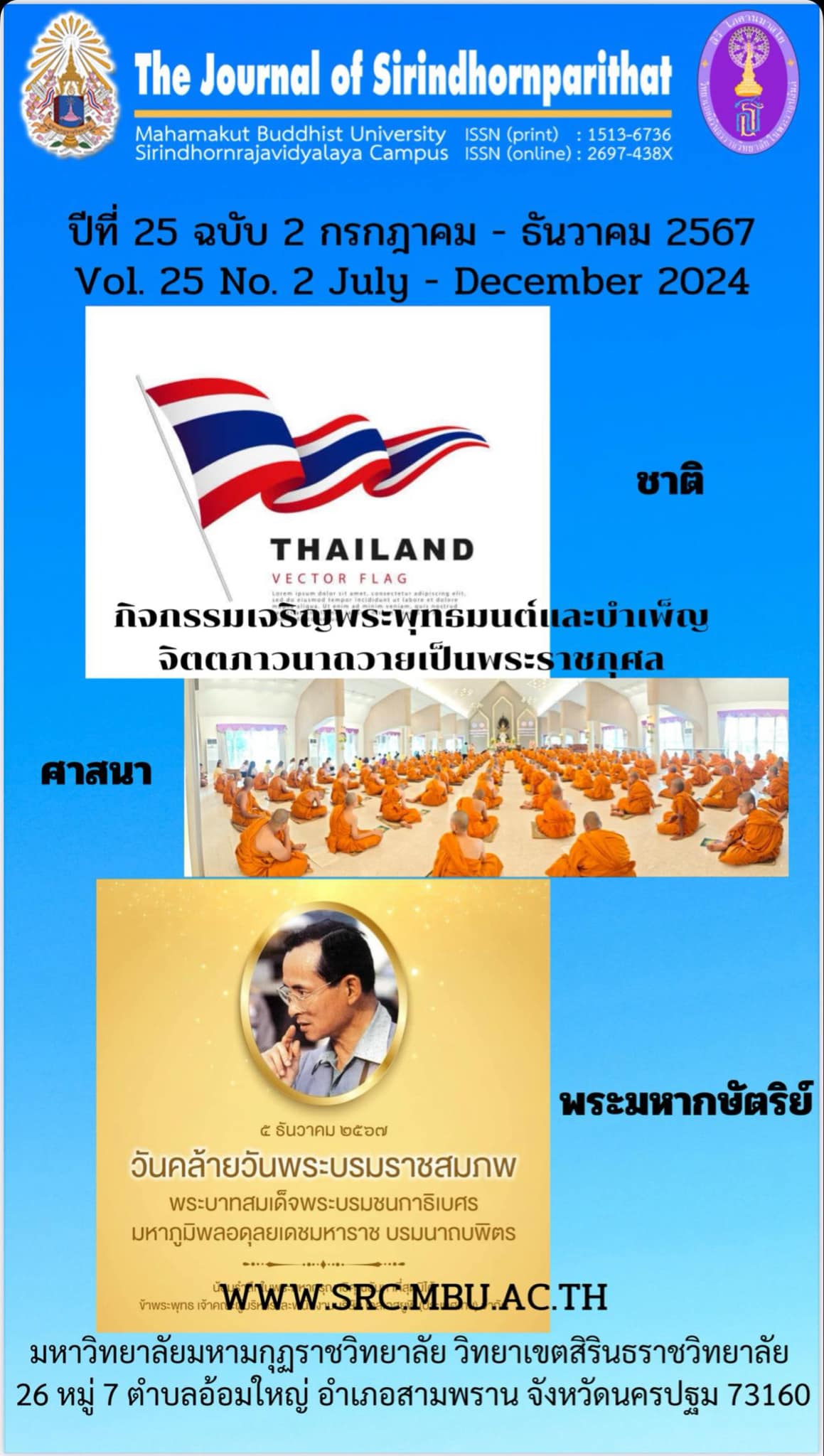The Pattern of Merit Dedication in Theravada Buddhism
Keywords:
Model, The Pattern of Merit Dedication, Theravada BuddhismAbstract
The dissertation on “The Pattern of Merit Dedication in Theravada Buddhism” had the objectives: 1) to study the merit and the approach for making the merit in Theravada Buddhism, 2) to study the pattern of the merit dedication in Theravada Buddhism, and 3) to present the pattern suitable to the merit dedication in Theravada Buddhism. The research applied the Qualitative Research with the Field Research from the interview with 15 experts and the focus group discussion with 7 experts. The data analysis used the content analysis.
The research results were as follow:
- The concept of merit and approach for making the merit in Theravada Buddhism found that the merit meant Pattidànamaya (the merit by sharing) divided into 2 practice principles: Punnakiriyà-vatthu 3 and the merit from giving that had 2 types: Amisadàna (material gift) and Dhammadàna (spiritual gift) that had 2 types: Vitdayadana (imparting of knowledge for the general benefit) and Abhayadana (forgiveness). Moreover, the Dana had 3 levels: the primary Dana, the middle Dana and the high Dana. Making the merit had 3 characters: giving and observing the religious precepts, practice meditation, and the wisdom development. Punnakiriyà-vatthu 3 (bases of meritorious action) consisted of Dànamaya (meritorious action consisting in giving or generosity), Sãlamaya (meritorious action consisting in observing the precepts or moral behavior), and Bhàvanàmaya (meritorious action consisting in mental development). Therefore. The objective of making the merit in Buddhism was leading the parents and their relatives to the heaven. It indicated that the belief in making the merit to the living of the Buddhists made their mind happy. The wholesome action made the happiness. The belief in Dana, Merit, Kamma happened from the belief in the law of Kamma: Kusala-kamma (wholesome action), Akusala-kamma (unwholesome action), and Abyàkata-kamma (the indeterminate).
- The pattern of the merit dedication in Theravada Buddhism found that the history and goal of the merit dedication in the Buddha’s time were Summodaniyakatha (giving a short speech). The goals of merit dedication had 5 aspects: 1) to make the benefit to the dead, 2) to express their duties to their relatives, 3) to worship their dead, 4) to give the power to the monks that were the parts of the Buddhist inheritors, and 5) to attempt for making the merit by themselves.
- The pattern suitable to the merit dedication in Theravada Buddhism found that the pattern of the merit dedication had 4 patterns consisting of 1) the pattern of the merit dedication with the mental prayer, 2) the pattern of the merit dedication with the speech, 3) the pattern of the merit dedication with sharing the loving-kindness, and 4) the pattern of the merit dedication with pouring water.
References
มหาวิทยาลัยมหาจุฬาลงกรณราชวิทยาลัย, พระไตรปิฎกฉบับภาษาไทย. กรุงเทพมหานคร: โรงพิมพ์มหาจุฬาลงกรณราชวิทยาลัย, 2539.
พระพรหมคุณาภรณ์ (ป.อ.ปยุตฺโต) ความสำคัญของพระศาสนาในฐานะศาสนาประจำชาติ, พิมพ์ครั้งที่ 11, กรุงเทพมหานคร : บริษัท สหธรรมิก จำกัด, 2555.
พระราชธรรมโสภณ (จำปี พงไทยสง), “ศึกษาหลักจริยธรรมประเพณีการทำบุญแจกข้าวของชาวพุทธ บ้านคูเมือง อำเภอสรวง จังหวัดร้อยเอ็ด” วิทยานิพนธ์พุทธศาสตรมหาบัณฑิต, บัณฑิตวิทยาลัย มหาวิทยาลัยมหาจุฬาลงกรณราชวิทยาลัย, 2551.
พระธรรมปิฎก(ป.อ.ปยุตฺโต) ,พจนานุกรมพุทธศาสน์ ฉบับประมวลศัพท์,กรุงเทพมหานคร : โรงพิมพ์มหาจุฬาลงกรณราชวิทยาลัย, 2538.
พระอธิการชัยรัตน์ ญาณวีโร, “ศึกษาความเชื่อเรื่องเปรตที่มีปรากฏในประเพณีการทำบุญของชาวอีสาน : กรณีศึกษาประเพณีการทำบุญข้าวประดับดินและบุญข้าวสาก”, วิทยานิพนธ์พุทธศาสตรมหาบัณฑิต, บัณฑิตวิทยาลัย มหาวิทยาลัยมหาจุฬาลงกรณราชวิทยาลัย, 2553.
พระมหาสุพจน์ คำน้อย, “การศึกษาวิเคราะห์คำสอนเรื่องการอุทิศส่วนบุญในพระพุทธศาสนาเถรวาท” รายงานวิจัย, คณะศิลปศาสตร์ มทยาลัยธรรมศาสตร์, 2547.
Downloads
Published
Issue
Section
License
Copyright (c) 2024 Mahamakut Buddhist University

This work is licensed under a Creative Commons Attribution-NonCommercial-NoDerivatives 4.0 International License.
บทความที่ได้รับการตีพิมพ์เป็นลิขสิทธิ์ของ มหาวิทยาลัยมหามกุฏราชวิทยาลัย วิทยาเขตสิรินธรราชวิทยาลัย
ข้อความที่ปรากฏในบทความแต่ละเรื่องในวารสารวิชาการเล่มนี้เป็นความคิดเห็นส่วนตัวของผู้เขียนแต่ละท่านไม่เกี่ยวข้องกับหาวิทยาลัยมหามกุฏราชวิทยาลัย วิทยาเขตสิรินธรราชวิทยาลัย และคณาจารย์ท่านอื่นๆในมหาวิทยาลัยฯ แต่อย่างใด ความรับผิดชอบองค์ประกอบทั้งหมดของบทความแต่ละเรื่องเป็นของผู้เขียนแต่ละท่าน หากมีความผิดพลาดใดๆ ผู้เขียนแต่ละท่านจะรับผิดชอบบทความของตนเองแต่ผู้เดียว




